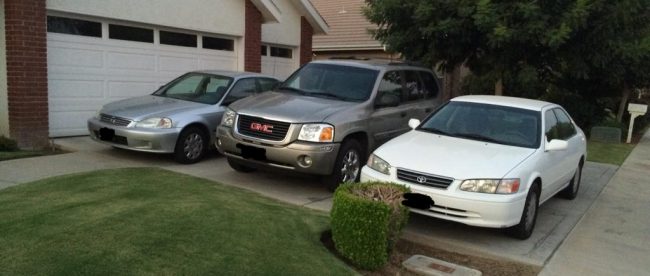Why We Park on Driveways and Drive on Parkways

English is a funny language for many, many reasons. And a common way to make this point is via a jokey observation of unknown origin: “Why do we drive on parkways and park on driveways?” As that makes no sense, neither does English or so it goes.
So, let’s answer that question. Why do we drive on parkways and park on driveways?
Let’s start with driveway first, in part because the question isn’t really accurate here. While you can park on a driveway (and as it turns out, I write this, my car is parked in my driveway) you can drive on it, too. And when the word was first coined, that was its primary use. The word “driveway” — originally “drive-way” — was first coined in 1839, according to Merriam-Webster, which means it predates cars by a good amount. But that’s okay because we had other vehicles way back when, such as horse-drawn carriages and ox-laden wagons. That’s what “driveways” are a reference to; per M-W, “the earliest driveways were roads that ran alongside barns, where vehicles like wagons could drive up and either offload cargo (like hay, food, or livestock) or take on cargo.”
Today, driveways are still little private roads. Your driveway at home connects your house to the main road — it’s still the path by way of which you drive in order to drive some more. As they’re shorter than they used to be, we do so less often than farmers and ranchers of the mid-1800s did. Similarly, we park there a lot more and for longer periods than drivers from a century and a half ago did. But our driveways, basically, still serve the same purpose they did way back when — unless your garage connects right to a public road or something weird like that.
So when “driveway” was first coined, we drove on them — and the fact that we do less and less doesn’t change its history. So when “parkways” were originally created, we parked on them, right? Nope — quite the opposite, in fact. That word took a different path.
Like “driveway,” the term “parkway” also predates the motor vehicle; it’s probably from the 1870s. It comes from the word “park,” which itself comes the mid-13th century. “Park” — then and now — means, basically, an enclosed space. As populations expanded, communities wanted places which were set apart from the hubbub of daily life, so they created these separate areas and named them “parks” after the Old English word for “fence.” Whether it’s Central Park in Manhattan or a small one in your neighborhood, parks are typically places where kids run around and play — it’s quite literally the last place you want someone driving around.
But cars need to be able to from point A to point B, and having a park in the way isn’t going to prevent that. As methods of transportation emerged and became increasingly common, communities needed to find ways to keep cars out of the park. As Mental Floss explains, the solution simple: “special car-friendly routes were carved through such parks.” These car paths were, literally, a “way through the park” — or, put another way, “parkways.” And because those parkways were typically straight-shots through parks or other wooded areas, “parkways” were places that cars could travel at pretty high speeds unabated. And that’s how we use the term today.
So to recap, we have “driveways” because we used to drive on them. And we have “parkways” because we used to drive on them instead of driving into the places they cut through. That’s the explanation, at least, and if you think about it, it’s still pretty weird.
Bonus fact: If we don’t want cars and parks to mix, then where does the word “parking” come from?
While early parks were these nature preserves, the word “park” returned to its roots over the centuries and now applies to enclosed spaces of all types. Baseball teams play at ballparks, Disneyland is a theme park, that fictional island with reborn dinosaurs is Jurassic Park. A place where you have a lot of vehicles may even be called a “car park” (and confusingly, it’s filled with parked cars), but that’s neither here nor there because the word “parking” predates car parks.
In the late 1700s and into the 1800s, armies needed a place to store their howitzers and other cannons. So they created an enclosed area just for this purpose — and they called it a “military park.” That was probably the first time that parks were used for storage, and as the Straight Dope explains, in 1812, the word “park” took on a new meaning — it became a verb meaning “to store one’s howitzers in a military park.” Shortly thereafter, the verb “to park” morphed to include other things with wheels — horse carriages and then to cars. And because of that, we have the word “parking.”
From the Archives: How a Strange Car Accident Turned Out A-OK. The perils — and silver linings — of parking on a driveway during a meteor shower.
